James Wheelock Mills
James Wheelock Mills (1856?, Staten Island NY to between 31 July 1857 and 19 Jun 1860, Staten Island NY). (Likely) third child of Edward Hallock and Mary Ann Mills. The only evidence I have found for the existence of James Wheelock Mills is his baptism record in the Reformed Dutch Church of Port Richmond, Staten Island NY.
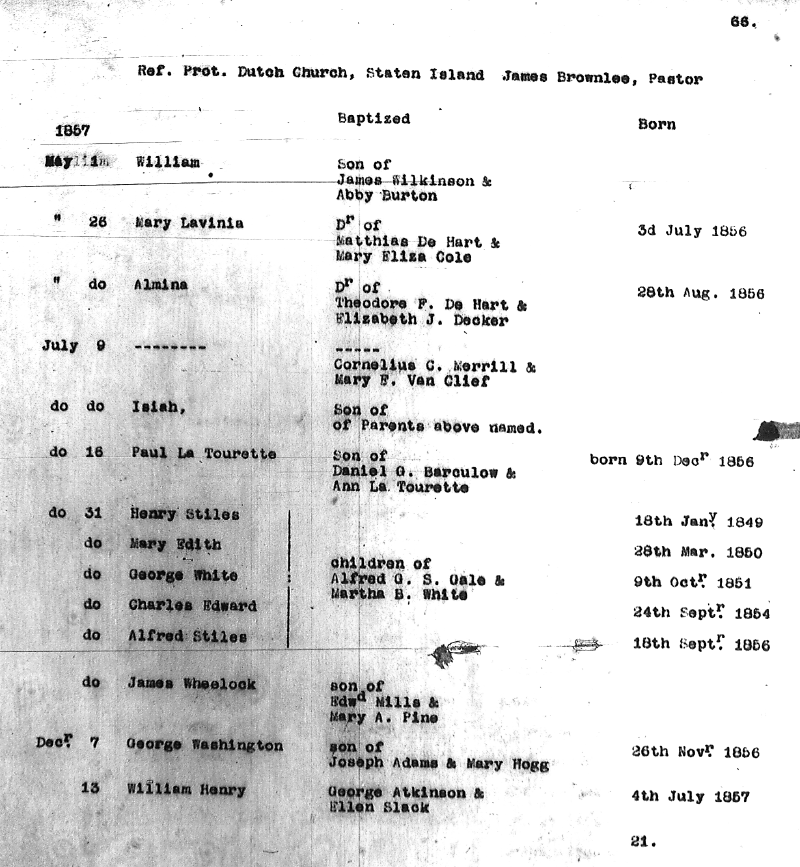
Date Baptized Parents’ Names Born 1857, July 31 James Wheelock son of Edwd Mills & Mary A. Pine
— Jan 1923, Records of the Reformed Protestant Dutch Church on Staten Island, New York City, transcribed and edited by Royden Woodward Vosburgh, v2, p66, Staten Island, Richmond County, NY Genealogical Resources, FHL Film 514656 Item 5. Partial transcription.View largest available size.
Because this is the only information I presently have for James, I asked Kathleen Langdon of the Reformed Dutch Church to photograph the original entry, which she graciously agreed to do. This also verifies James’ middle name as it was originally recorded, which I had initially speculated could be a mis-transcription of “Hallock”. This possibility is explored further below.
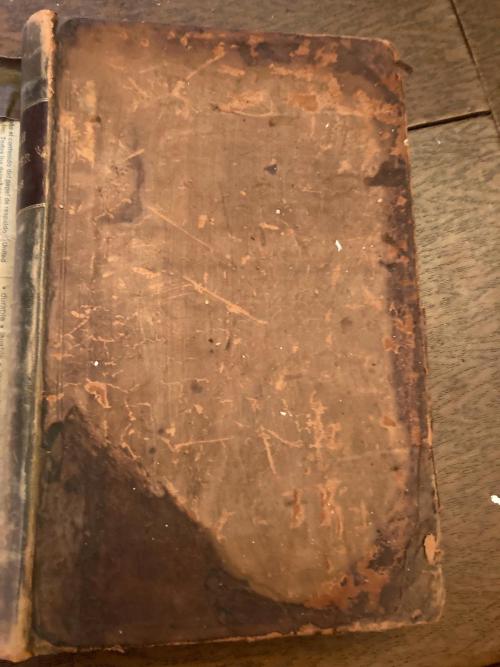
— Church Register 1790-1908, Reformed Dutch Church of Port Richmond, Cover. Digitally photographed by Kathleen Langdon and used with permission via personal correspondence 05 Feb 2023. View largest available size.
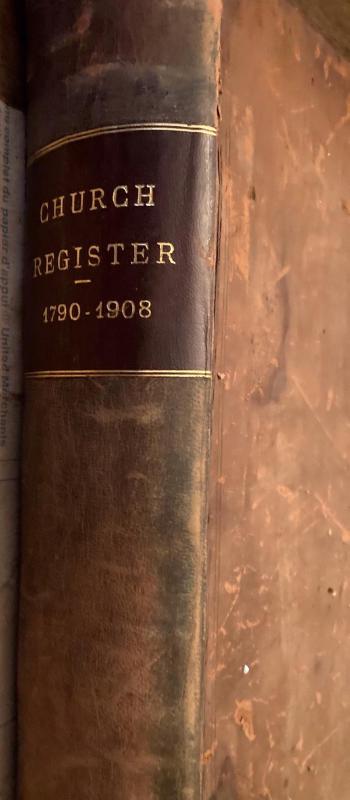
— Church Register 1790-1908, Reformed Dutch Church of Port Richmond, spine and cover. Digitally photographed by Kathleen Langdon and used with permission via personal correspondence 05 Feb 2023. View largest available size.

— Church Register 1790-1908, Reformed Dutch Church of Port Richmond, spine. Digitally photographed by Kathleen Langdon and used with permission via personal correspondence 13 Feb 2023. View largest available size.
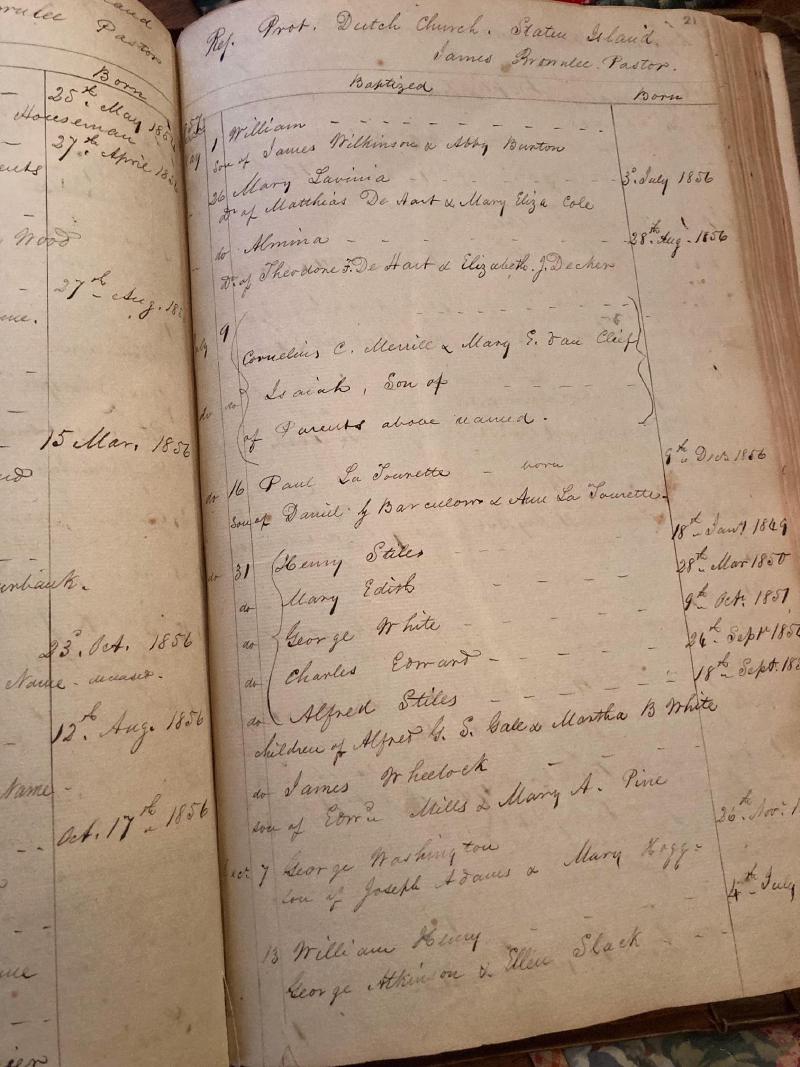
— Church Register 1790-1908, Reformed Dutch Church of Port Richmond, p21. Digitally photographed by Kathleen Langdon and used with permission via personal correspondence 05 Feb 2023. View largest available size.
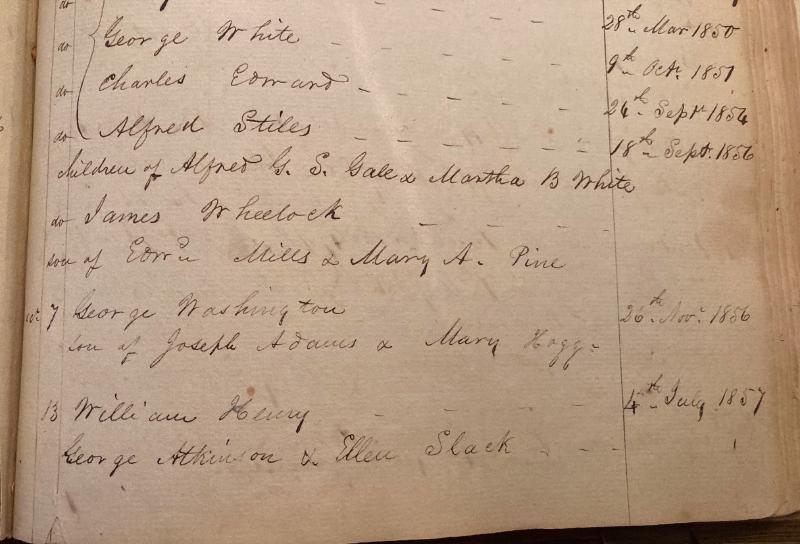
— Church Register 1790-1908, Reformed Dutch Church of Port Richmond, p21. Digitally photographed by Kathleen Langdon and used with permission via personal correspondence 05 Feb 2023. View largest available size.
Note several bounding dates for James’ birth and death: he was presumably born sometime after Edward and Mary Ann married on 29 Dec 1850, and presumably died between the date of his baptism, 31 Jul 1857, and before the United States Federal Census recorded on 19 Jun 1860 which includes the entire Mills family except James. As yet, I have not found the Mills family in the 1850 United States Federal Census or the 1855 New York State Census, but I suspect that he was born after the 1855 census.
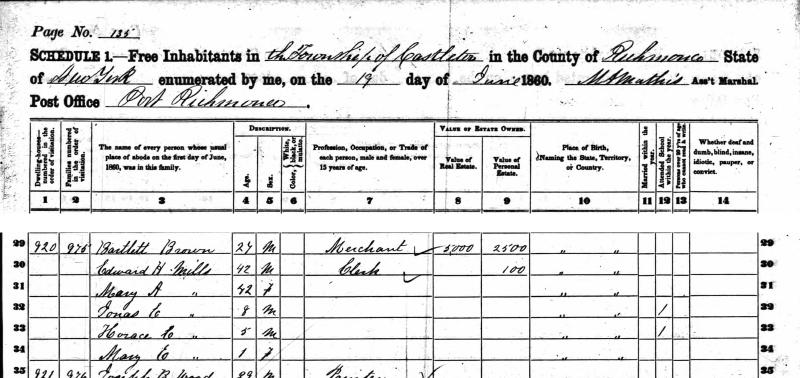
— 19 Jun 1860, United States Federal Census, Castleton NY, p135, ancestry.com. View largest available size.
Both the date of his baptism, and the order of the Mills children baptisms overall strongly suggests that James was born between Horace and Emily, and if James was born in 1856, this would evenly distribute the Mills births over the decade of 1850 to 1680, and would mean that his baptism was likely approximately a year after his birth, just as Emily’s was in Nov 1859. So, I believe that James likely died under five years old.
This would mean that the Mills left Staten Island within a few years of James’ death, just as they left Corfu a few years after Horace’s. If my speculation holds, even if James died at the latest possible time, Emily would likely have not had memories of him.
Aside from his baptism record, I cannot find any other records for James in The Records of the Reformed Protestant Dutch Church on Staten Island, including many pages of gravestone transcriptions. Kathleen Langdon from the Reformed Dutch Church performed an independent search and also could not find him. Finally, I have also examined the First of Staten Island/Stapleton records on Ancestry.com, and I did not find evidence of the Mills there. Likewise, James is not within the volume: 1940, Cemetery Inscriptions from Hempstead, Long Island New York by Josephine C. Frost, familysearch.org. Nor can I find James in available listings for Mills Cemetery or any other cemetery in Smithtown.
I have not found James in any records on FindAGrave, FamilySearch, or Ancestry.
Decades after the Mills left Staten Island, members of Charles Pine’s family were buried in Moravian Cemetery in New Dorp.
Moravian Cemetery, located at 2205 Richmond Road, opened in 1740 and is the largest and oldest active cemetery on Staten Island.
In what was a purely farming community, the 113-acre (46 ha) cemetery was originally made available as a free cemetery for the public in order to discourage families from using farm burial plots. The Moravian Cemetery is the burial place for a number of famous Staten Islanders, including members of the Vanderbilt family.
Wikipedia also notes that “After the closure in the 1880s of the South Reformed Dutch Church in Richmondtown the graves of that church’s graveyard were reinterred at Moravian.”
In addition to using both findagrave.com and the burial search feature of the Moravian Cemetery website and not finding James, I contacted Moravian Cemetery directly, and after a search, the representative I spoke to also did not find James. Despite this, I cannot completely rule out the possibility that James is buried in Moravian. I strongly suspect that the representative I spoke to used the same burial search I had used, or a similar search based on the same digital records, thus only replicating my efforts and not actually corroborating my results. I can confidently assert that not only are the Moravian digitized records incomplete, but I suspect, quite incomplete. I have used the burial search to look for several members of the Pine and Brown families that multiple independent sources state are buried in Moravian, yet I cannot retrieve them using the burial search, again, despite trying multiple variations of the names, including initials, switching first and last names, etc. The graves I am looking for are not particularly ancient, especially for Moravian, and the fact that such a high percentage of people I looked for cannot be retrieved, suggests to me ample room to find James among his Pine relatives there.
I contacted Moravian Cemetery again, asking them to double-check their original print records for James, and received the following response:
James Mills is not buried with the Pine family. For me to check further I would need his date of death and the name of the family he’s buried with.
— 10 Jan 2024, Richard Simpson, personal correspondence.
There are other possible candidates in Staten Island for James’ final resting place. The Beers map of Staten Island shows Staten Island Cemetery, Trinity Chapel/Church of the Ascension, and Fountain Cemetery are clustered together in the general vicinity of Pine, Hillyer & Co. general store, where Edward was presumably employed.
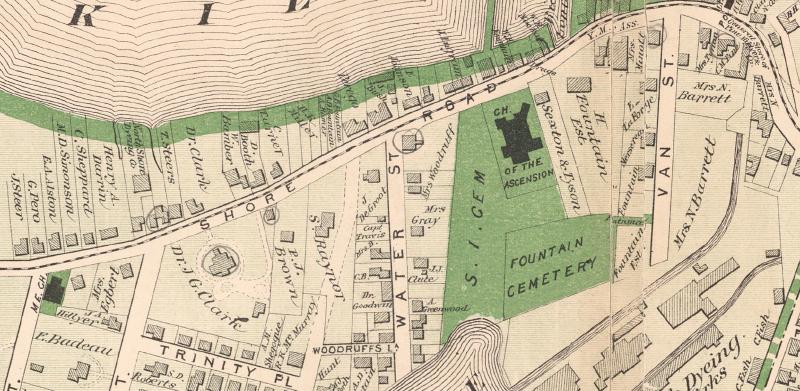
— Lionel Pincus and Princess Firyal Map Division, The New York Public Library. “Atlas of Staten Island, Richmond County, New York, from official records and surveys; compiled and drawn by F. W. Beers” The New York Public Library Digital Collections. 1874. Cropped https://digitalcollections.nypl.org/items/510d47e2-0b93-a3d9-e040-e00a18064a99. View largest available size.
Staten Island Cemetery about 1847 and Trinity Cemetery about 1800 both are located in West New Brighton.
...It is very difficult to find a burial from 1850 if it is not on any known burial list. The original records from Fountain & Staten Island cemetery are old and brittle. The burials prior to 1880 were not well kept and it seems semi literate recordings. There are very few documented deaths at that time as well. No death certificates were issued.
Children were not always buried by name. Staten Island Cemetery has an area for less expensive child burials, they are recorded as "lot of 5 childs" or Mrs. Mills child, John M's child, etc. If the child you are seeking was buried there, no exact record will be found.
— 20 Feb 2023, Friends of Abandoned Cemeteries of Staten Island, personal correspondence.
The “Trinity Cemetery” mentioned above is presently known as Trinity Chapel Burying Ground:
Trinity Chapel Burying Ground est. abt. 1799 was at one time attached to Trinity Church which became Church of the Ascension abt 1870 -and is one of FACSI abandoned cemeteries. Also at this location is Staten Island and Fountain Cemeteries (2 cemeteries). S.I. Cemetery took over the care of Trinity . Now FACSI takes care of the lot of them.Trinity Methodist Church Cemetery - is now part of St. Johns Lutheran church in Port Richmond. It is a tiny cemetery attached to a tiny church that is still active today - not part of FACSI
Friends of Abandoned Cemeteries of Staten Island (FACSI), have lists of many Staten Island cemetery burials. There is a James C. W. Mills in Fountain Cemetery, who died at age 47 on 18 Apr 1893 (FACSI ID 353), and a James Mills buried in the row 5, grave 11 of the Fountain Cemetery Public Grounds who died 13 Jun 1889. There are also two unnamed Mills in Fountain Cemetery, in lot 080 and lot 095 (FACSI IDs 665 and 709 respectively), ages and death dates are unknown, but FACSI indicates that there are known burials in Fountain Cemetery from the 1860’s, so these last two cannot be ruled out.
FACSI also notes a number of burials identified simply as being on “Van Street”. No Mills are listed there, and the dates of the burials at that location were decades after the Mills left Staten Island.
Finally, Samuel J. Wood Library at Weill Cornell Medicine has records starting from 1854 from the Nursery and Child’s Hospital, and I contacted them about a search for James. This was a unlikelihood anyway, and became moot as even to search for him, they required the very information I was looking for: exact date of death, death certificate, etc., and even then, I would have to sign an agreement to de-identify the information, defeating the purpose.
(The Staten Island “country branch” of the hospital didn’t open until 1869.)
Exploring “Wheelock”
Initially, I explored the theory that “Wheelock” could be a mis-transcription of the much less surprising “Hallock”, given how similar the two names might look written in script, however Kathleen Langdon’s photographs of the originally written entry prove that wrong. However, I am still intrigued by the similarity of the two names, especially phonetically, leading me to wonder if the church secretary misheard “Hallock” as “Wheelock”. Obviously this theory is purely speculation without evidence and can’t be proved or disproved, but I present the following for consideration.
Spelling variations of this family name include: Weelock, Wheelock, Wellock, Whellock, Whillock, Whealock and many more.
The surname Wheelock was first found in Cheshire as Wheelock, a township, in the parish of Sandbach, union of Congleton, hundred of Northwich.
The township dates back to the Domesday Book or 1086, when it was listed as Hoiloch, "named from the River Wheelock, a Celtic river-name meaning 'winding'".
The most common accepted definition of the name is as follows:
The name of the village is first recorded as Hoileck, and Hoiloch in the Domesday book then Changed in 1316 to Quelock and again in 1382 to Whelock, in 1384 to Welock, finally in 1390 it sees to have settled, and recorded as Wheelock as it is known today. The main reason for changes stem from people spelling as they sound it.
The word come from the word Chevel-og meaning winding, twisting, turning and the conclusions seem to be the river with its many twists and turns until they reach the central body of the river outside the village
The second but more obscure definition is as follows:
The development of Wellock via Wailock, Wallock from walok in 1379. This is the form which requires explanation and the evidence suggests that it was a diminutive of a personal or Christian name 'Wal'. This may have been meaningless when used in the 1300s, but etymologically it is probably the Old English word 'walh' meaning 'stranger' or 'foreigner'.
Similarly, many variations of the family name “Hallock” are known and were even used by the families within the Hallock genealogy. Records of the Mattituck Presbyterian Church, which Edward’s grandfather Thomas attended as a young man prior to his marriage, contain multiple spellings of “Hallock” including “Halloc”, “Halock”, “Haliock”, “Halliock”, and even “Hallaock”. Records of the Smithtown Presbyterian Church, where several members of the Hallock family are listed as members, including Edward’s grandparents later in life, also contain spelling variations, including both “Hallock” and “Halliock”. The Hallock family genealogists spent considerable effort accounting for this very issue:
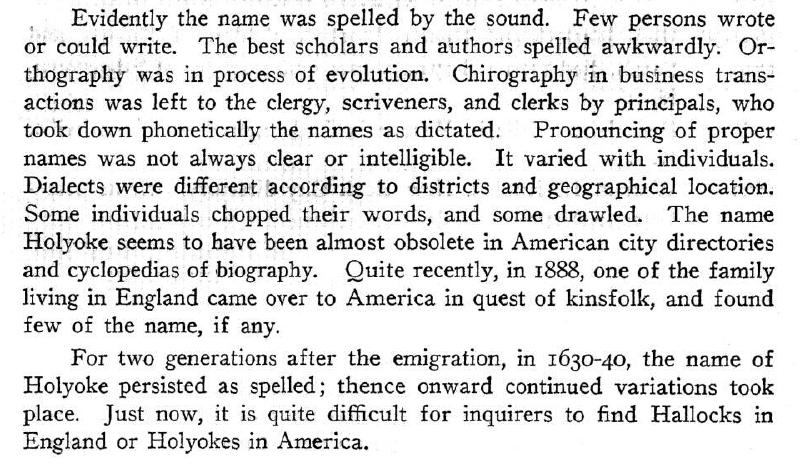
Evidently the name was spelled by the sound. Few persons wrote or could write. The best scholars and authors spelled awkwardly. Orthography was in process of evolution. Chirography in business transactions was left to the clergy, scriveners, and clerks by principals, who took down phonetically the names as dictated. Pronouncing of proper names was not always clear or intelligible. It varied with individuals. Dialects were different according to districts and geographical location. Some individuals chopped their words, and some drawled. The name Holyoke seems to have been almost obsolete in American city directories and cyclopedias of biography. Quite recently, in 1888, one of the family living in England came over to America in quest of kinsfolk, and found few of the name, if any.
For two generations after the emigration, in 1630-40, the name of Holyoke persisted as spelled; thence onward continued variations took place. Just now, it is quite difficult for inquirers to find Hallocks in England or Holyokes in America.
— 1928, A Hallock genealogy: an attempt to tabulate and set in order the numerous descendants of Peter Hallock, who landed at Southold, Long Island, New York about the year 1640 and settled at Aquebogue, near Mattituck by Lucius Henry Hallock, p13, familysearch.org. View largest available size.
For a fuller treatment of these Hallock spelling variations, read this section and consider the possibility that Wheelock is a perhaps previously unknown “diatonic” of Hallock.
The name “James” itself may lend weight to the theory that “Hallock” was mis-recorded as “Wheelock”, as James is a common name in the Hallock genealogy. Edward’s son James may have been named after Edward’s brother James, or, either or both may have been named for Edward’s great-grandfather, James Hallock (1731 to 27 Sep 1775). Further testament to the popularity of the name James in the Hallock family is James Hallock, a distant relative of Edward Mills, who lived in Slaterville for many years while Edward was living in Brookton. James is the son of William B. Hallock, who is explored further in the section: Hallocks in Caroline and the Hallock Genealogy.
The name James is also found in the Pine genealogy, including an early settler of Hempstead, as well as James Pine (Nov 1767 to 20 Dec 1847) who was an elder in Christ’s First Presbyterian Church. (This appears to be the “Elder Pine” referenced in the 250th Anniversary Souvenir book.)
Assuming the name “Wheelock” is correct as written, as the evidence indicates, why was Wheelock chosen? My initial expectation was that the distinctiveness of the Wheelock name would make it easier to find the answer. Presumably he is named for someone, a tradition that was followed to an extreme by the Mills, who tended to re-use a small pool of names repeatedly, and usually the names of those very close to them, yet I cannot find the name in the available genealogical data for the Mills, Pine, Hallock, Seaman and Hawkins families. The inverse is also true: a search of The Wheelock family in America, 1637-1969 compiled by Walter T. Wheelock (familysearch.org), reveals one reference to an unrelated Mills family in Hartford CT, and no references whatsoever to the names Pine, Hallock or Seaman.
(For comparison, Horace’s middle name “Franklin” is rare, but not unique in the Mills genealogy.)
Nor do I recall encountering Wheelock in the genealogical data I have reviewed for related families such as Hawkins and Brown, nor among the names of known business associates, fellow church members, etc., nor in the available census records I have reviewed, although admittedly, I only discovered James once I was a few years into this research, so I may have encountered the name at a time when it would not have caught my attention.
I asked Martha Deed, great-granddaughter of Juliett (Loper) Shepard, if she knew anything of the name “Wheelock”:
No Wheelock. There is a Mary Hallock (1800, Westchester County, NY - 1870 Westchester County, NY) who was married to a very distant Conklin ancestor of mine, John C Conklin 1800-1878. They appear to be Quakers and are buried in the Friends Cemetery in Amawalk, NY.
…Mills is a surname in my tree, but is part of my incomplete work on ancestors from Kingston and Duxbury, Plymouth County, so may be of little help.
— 31 Oct 2023, Martha Deed, personal correspondence.
One possibility I should point out, though it may be unlikely. In all of the documents referencing Bartlett Brown, the grocer in whose home the Mills lived for part of their time in Staten Island, most likely overlapping the time James was yet living, I believe I have only seen one source, the New York State Death Index, that even hints at Bartlett’s middle name, which the Index recorded “W”. But if Edward wanted to honor his friend, it seems “James Bartlett Mills” or “James Brown Mills” would be more logical choices. And perhaps a clue to Bartlett Brown’s full middle name can be found in the middle name of his grandson Farrington Wade Brown (01 Dec 1894 to 27 Sep 1963).
Perhaps it is worth further investigation to search for a possible business relationship between the West New Brighton grocers and William Almy Wheelock (23 Mar 1825 to 06 Jul 1905) who was a dry goods jobber throughout the 1850’s in Manhattan, creating a fortune for himself at a young age. In the 1850 United States Federal Census in New York Ward 17 (Ancestry.com), William Snedecker’s occupation appears to be “hosiery” and William Wheelock’s dry goods businesses routinely featured hosiery among their advertised products. By 1859, William Snedeker is also a dry goods jobber, operating several blocks away from William Wheelock. And note that William Wheelock’s middle name is also that of William Snedeker’s wife, Lois Almy (Pine) Snedeker, Mary Ann’s sister. But aside from this modest collection of apparent coincidences, I don’t have any direct evidence connecting William Wheelock to the Pines or Mills.

BLISS, WHEELOCK & KELLY,
SUCCESSORS TO BLISS, DOUGLAS, WHEELOCK & CO.,
112 & 114 Duane street, Opposite the N. Y. Hospital, AND 70 & 72 READE STREET, (Near Broadway,)
Importers and Jobbers of STAPLE DRY-GOODS, HOSIERY AND EMBROIDERIES, WHITE GOODS, LINENS, &c., &c., &c.
aug16nptf
— 04 Sep 1858, The Evening Post, New York NY, p2, nyshistoricnewspapers.org. Emphasis added.View largest available size.
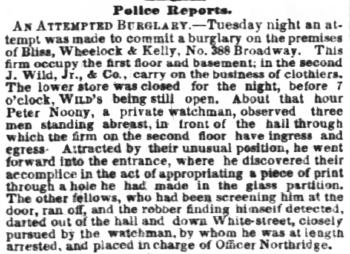
Police Reports.
AN ATTEMPTED BURGLARY.—Tuesday night an attempt was made to commit a burglary on the premises of Bliss, Wheelock & Kelly, No. 388 Broadway. This firm occupy the first floor and basement; in the second J. Wild, Jr., & Co., carry on the business of clothiers. The lower store was closed for the night, before 7 o’clock, Wild’s being still open. About that hour Peter Noony, a private watchman, observed three men standing abreast, in front of the hall through which the firm on the second floor have ingress and egress. Attracted by their unusual position, he went forward into the entrance, where he discovered their accomplice in act of appropriating a piece of print through a hole he had made in the glass partition. The other fellows, who had been screening him at the door, ran off, and the robber finding himself detected, darted out of the hall and down White-street, closely pursued by the watchman, by whom he was at length arrested, and placed in charge of Officer Northridge.
— 17 Feb 1859, The New York Times, New York NY, p5, newspapers.com. View largest available size.
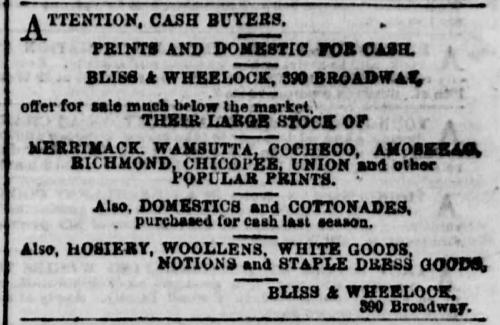
Attention, Cash Buyers,
Prints and Domestic for Cash.
Blissh & Wheelock, 390 Broadway, offer for sale much below the market, their large stock of Merrimack, Wamsutta, Cocheco, Amos[unclear], Richmond, Chicopee, Union, and other Popular Prints.
Also Domestics and Cottonades, purchased for cash last season.
Also, Hosiery, Woollens, White Goods, Notions and Staple Dress Goods,
Bliss & Wheelock, 390 Broadway.
— 14 Apr 1862, New York Daily Herald, New York NY, p5, newspapers.com. View largest available size.
Bliss, Douglass, Wheelock & Co. and the successor firm of Bliss Wheelock & Kelly were dry goods jobbers that operated concurrently with Mary Ann’s brother-in-law William Snedeker’s business, also listed as dry goods jobbers, several blocks south of Bliss et. al.
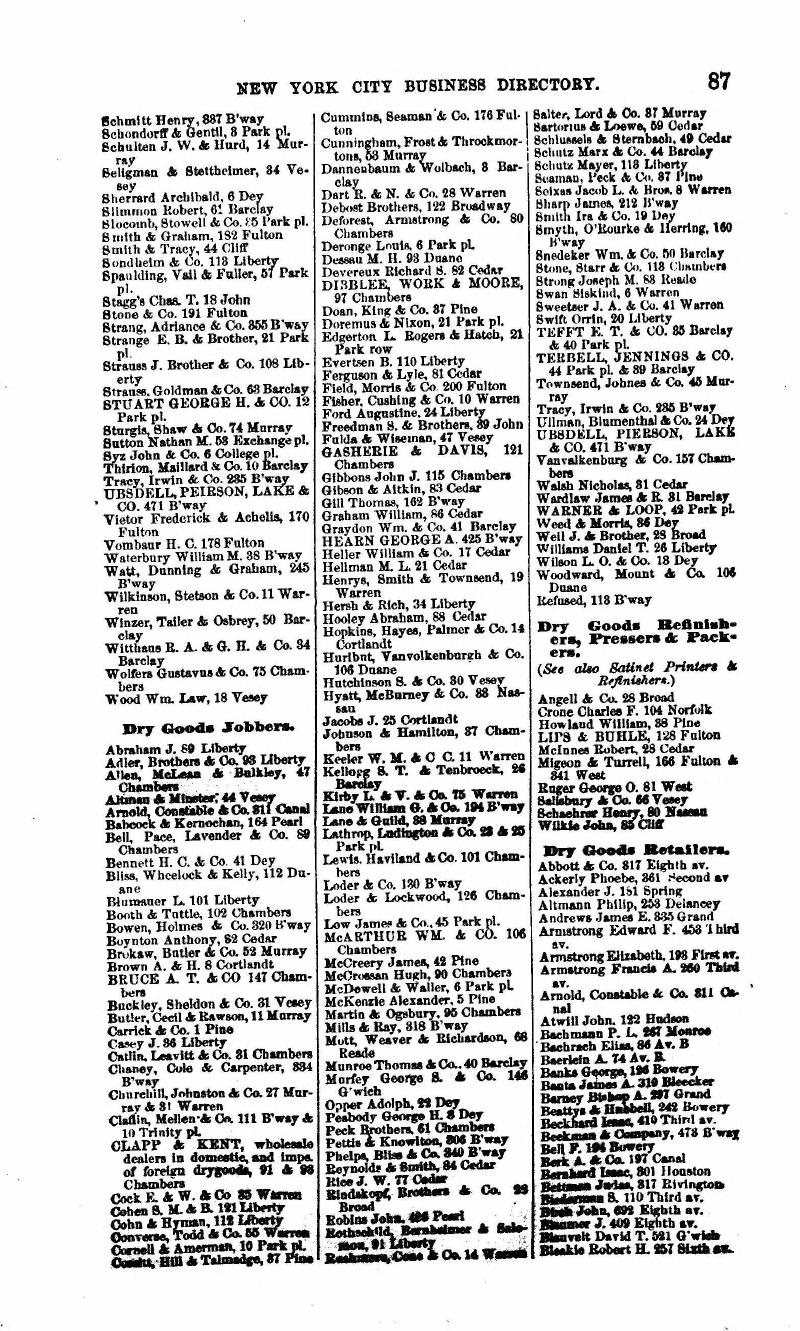
…Bliss, Wheelock & Kelly, 112 Duane
…Snedeker Wm. & Co. 50 Barclay
— 1859, New York City Business Directory, p87, ancestry.com. Partial transcription. View largest available size.
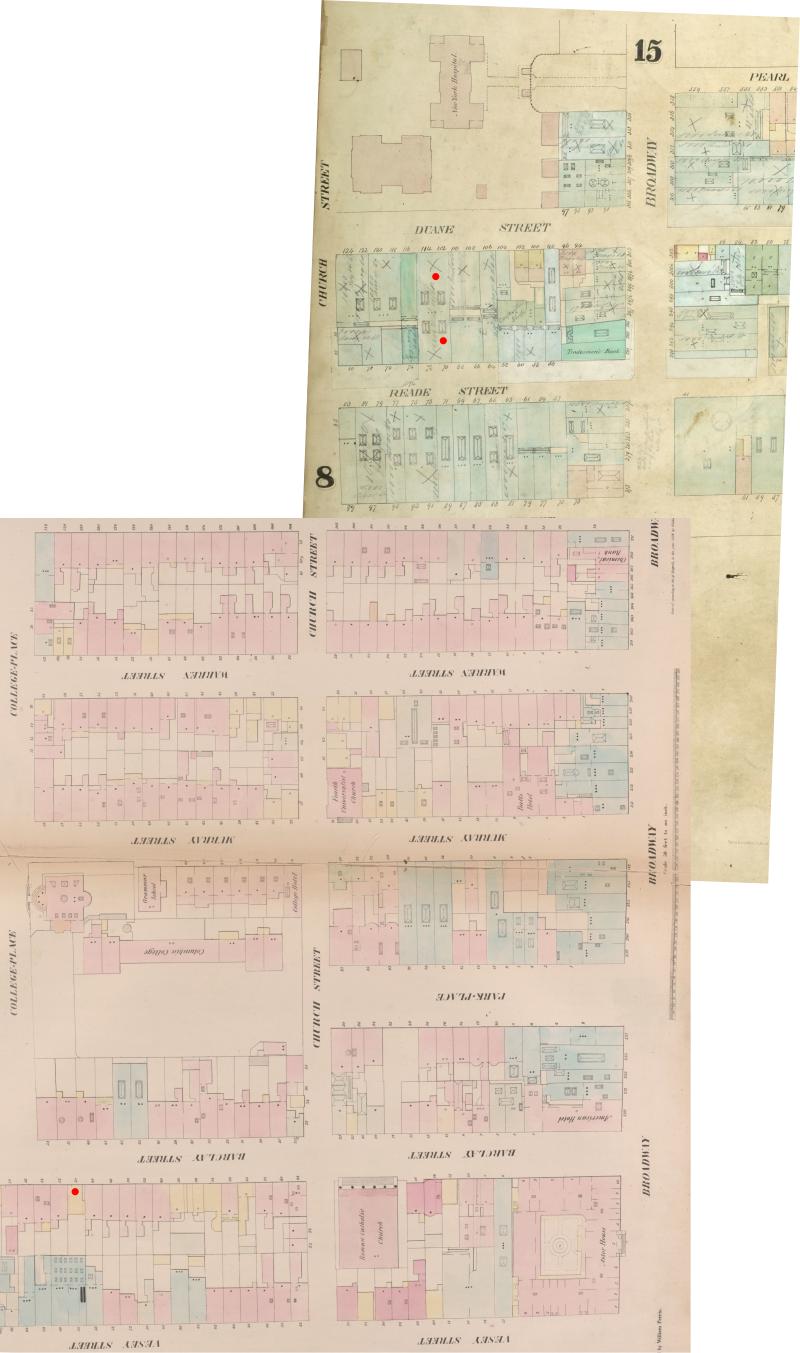
— This image combines cropped versions of these two maps: Lionel Pincus and Princess Firyal Map Division, The New York Public Library. “Plate 9: Map bounded by Pearl Street, Chatham Street, Duane Street, Rose Street, Frankfort Street, City Hall Square, Murray Street, Church Street” The New York Public Library Digital Collections. 1857 - 1862. https://digitalcollections.nypl.org/items/510d47e0-bf3e-a3d9-e040-e00a18064a99 and Lionel Pincus and Princess Firyal Map Division, The New York Public Library. “Plate 9: Map bounded by Pearl Street, Chatham Street, Chambers Street, Rose Street, Frankfort Street, Murray Street, Church Street; Including Duane Street, City - Hall Place, Reade Street, Warren Street, Broadway, Elm Street, Centre Street, Tryon Row, North William, William Street " The New York Public Library Digital Collections. 1857 - 1862. https://digitalcollections.nypl.org/items/5e66b3e8-c7e3-d471-e040-e00a180654d7. View largest available size.
Interestingly, not only the street names, but their relative numbering scheme is the same presently as they were in the 1850’s, and according to Google Maps, it is a six minute walk from Bliss, Wheelock & Kelly to Wm. Snedeker & Co. Snedeker’s establishment was just a few blocks northeast of the future site of 1 World Trade Center and 2 World Trade Center, the “Twin Towers” that collapsed in the September 11 attacks of 2001.

— 2023, Google Maps. View largest available size.
Perhaps William Wheelock was an investor in C. M. Pine & Co. in Staten Island, or E. H. Mills & Co., Corfu, as he was with Dale Dutcher & Co.
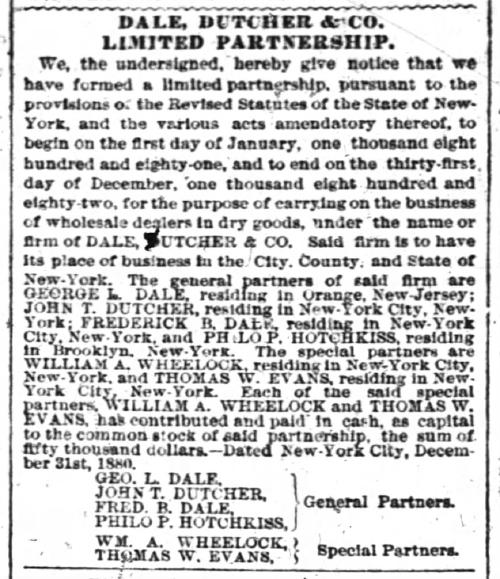
DALE, DUTCHER & CO. LIMITED PARTNERSHIP.
We, the undersigned, hereby give notice that we have formed a limited partnership, pursuant to the provisions of the Revised Statutes of the State of New York, and the various acts amendatory thereof, to begin on the first day of January, one thousand eight hundred and eighty-one, and to end on the thirty-first, day of December, one thousand eight hundred and eighty-two, for the purpose of carrying on the business of wholesale dealers in dry goods, under the name or firm of DALE, DUTCHER & CO. Said firm is to have its place of business in the City, County, and State of New-York. The general partners of said firm are GEORGE L. DALE, residing in Orange, New-Jersey; JOHN T. DUTCHER, residing in New-York City, New-York, and PHILO P. HOTCHKISS, residing in Brooklyn, New-York. The special partners are WILLIAM A. WHEELOCK, residing in New-York City, New-York, and THOMAS W. EVANS, residing in New-York City, New-York. Each of the said special partners, WILLIAM A. WHEELOCK and THOMAS W. EVANS has contributed and paid in cash, as capital to the common stock of said partnership, the sum of fifty thousand dollars.–Dated New-York City, December 31st, 1880.
GEO. L. DALE, JOHN T. DUTCHER, FRED B. DALE, PHILO P. Hotchkiss, General Partners.
WM. A. WHEELOCK, THOMAS W. EVANS, Special Partners.
— 01 Jan 1881, The New York Times, New York NY, p6, newspapers.com. View largest available size.
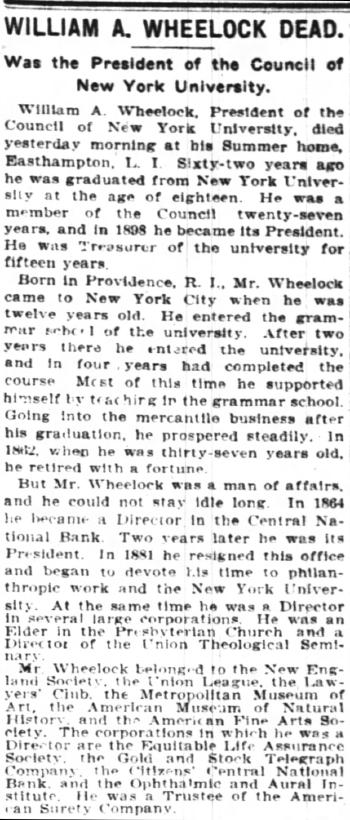
WILLIAM A. WHEELOCK DEAD.
Was the President of the Council of New York University.
Willlam A. Wheelock, President of the Council of New York University, died yesterday morning at his Summer home, Easthampton, L. I. Sixty-two years ago he was graduated from New York University at the age of eighteen. He was a member of the Council twenty-seven years, and in 1898 he became its President. He was Treasurer of the university for fifteen years.
Born in Providence, R. I., Mr. Wheelock came to New York City when he was twelve years old. He entered the grammar school of the university. After two years there he entered the university, and in four years had completed the course. Most of this time he supported himself by teaching in the grammar school. Going into the mercantile business after his graduation, he prospered steadily. In 1862, when he was thirty-seven years old, he retired with a fortune.
But Mr. Wheelock was a man of affairs, and he could not stay idle long. In 1864 he became a Director in the Central National Bank. Two years later he was its President. In 1881 he resigned this office and began to devote his time to philanthropic work and the New York University. At the same time he was a Director in several large corporations. He was an Elder in the Presbyterian Church and a Director of the Union Theological Seminary.
Mr. Wheelock belonged to the New England Society, the Union League, the Lawyers’ Club, the Metropolitan Museum of Art, the American Museum of Natural History, and the American Fine Arts Society. The corporations in which he was a Director are the Equitable Life Assurance Society, the Gold and Stock Telegraph Company, the Citizens’ Central National Bank, and the Ophthalmic and Aural Institute. He was a Trustee of the American Surety Company.
— 07 Jul 1905, The New York Times, New York NY, p7, newspapers.com. View largest available size.
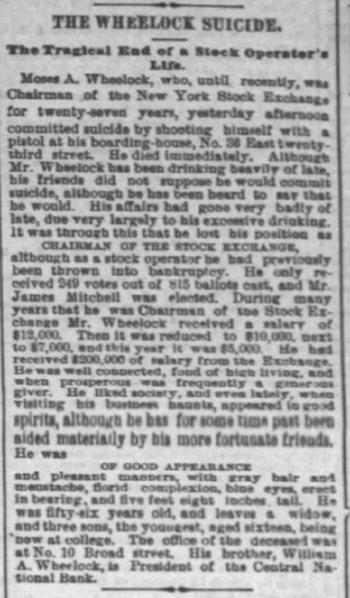
The Wheelock Suicide.
The Tragical End of a Stock Operator’s life.
Moses A. Wheelock, who, until recently, was Chairman of the New York Stock Exchange for twenty-seven years, yesterday afternoon committed suicide by shooting himself with a pistol at his boarding-house, No. 36 East twenty-third street. He died immediately. Although Mr. Wheelock has been drinking heavily of late, his friends did not suppose he would commit suicide, although he has been heard to say the he would. His affairs had gone very badly of late, due largely to his excessive drinking. It was through this that his lost his position as Chairman of the Stock Exchange…
— 24 Jun 1878, The Brooklyn Union, Brooklyn NY, p2, newspapers.com. Partial transcription.View largest available size.
Searching more broadly for Wheelocks, in the 1800’s, there are a number of Wheelocks in Brooklyn, central New York and Erie County. By 1890, there are Wheelocks in North Hempstead, notably, Daniel Wheelock, a farmer.
The Wheelocks living in Erie County, included in the following list, lived in Clarence at and around the time that the Mills Family of Erie County are living in Clarence, and Edward’s family are in Staten Island and later Corfu in Genesee County, perhaps 10 miles from Clarence:
Jeanette Wheelock (1845 to 1903).
Jesse Wheelock (15 Feb 1804 to 24 Nov 1887) who married Anna A. (Young) Wheelock (1812 to 23 Jul 1858). Their children:
John G. Wheelock (12 Sep 1839 to 11 Oct 1909).
Eugene J. Wheelock (1848 to 02 Feb 1866).
I also considered the possibility that Wheelock was not referring to a relative or someone else the Mills knew personally, but a famous person of the time. Although I can’t say this was never done in the Mills family, the overwhelming tradition was to reuse the same small set of names over many generations and even spanning across widely divergent branches of the family tree. Additionally the Wheelock I could find with any notoriety from the relevant time frame in America was Cyrus H. Wheelock:
Cyrus Hubbard Wheelock (February 28, 1813 – October 11, 1894) was an early missionary and leader in the Church of Jesus Christ of Latter-day Saints. He wrote the words to the Latter-day Saint hymn "Ye Elders of Israel". Wheelock was born at Henderson, Jefferson County, New York.
Wheelock Settlers in United States in the 19th Century
Charles Wheelock, aged 25, who arrived in New York in 1812
Alice Wheelock, who landed in New York, NY in 1816
A G Wheelock, who arrived in San Francisco, California in 1850
Finally, I looked into the previously mentioned James C. W. Mills, to see exactly what the “W” stands for, but I have not found documentation that spells out these initials. As far as I can tell, he is an unrelated Mills, not a descendant of Timothy Mills of Mills Pond nor of George Mills of Jamaica.
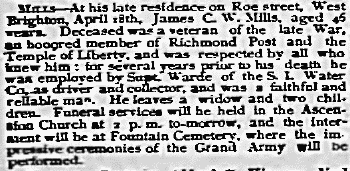
MILLS—At his late residence on Roe street, West Brighton, April 18th, James C. W. Mills, aged 46 years. Deceased was a veteran of the late War, an honored member of Richmond Post and the Temple of Liberty, and was respected by all who knew him; for several years prior to his he was employed by Supt. Warde of the S. I. Water Co. as driver and collector, and was a faithful and reliable man. He leaves a widow and two children. Funeral services will be held in the Ascension Church at 2 p.m. to-morrow, and the interment will be at Fountain Cemetery, where the impressive ceremonies of the Grand Army will be performed.
— 22 Apr 1893, Richmond County Advance, West New Brighton NY, p5, nyshistoricnewspapers.org. View largest available size.
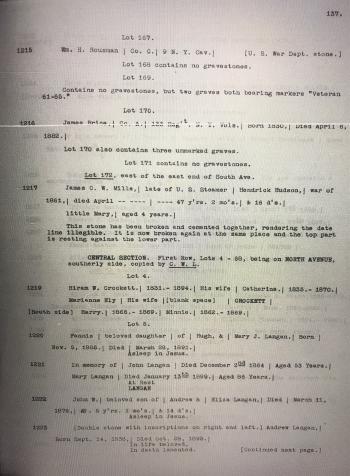
… Lot 172, east of the east end of South Ave.
1217 James C. W. Mills, late of U. S. Steamer Hendrick Hudson, war of 1861, died April – — —- 47 y’rs. 2 mo’s. & 16 d’s.
little Mary, aged 4 years.
This stone has been broken and cemented together, rendering the date line illegible. It is now broken again at the same place and the top part is resting against the lower part. …
— Fountain Cemetery grave transcriptions provided by Kathleen Langdon, personal correspondence, 28 Mar 2023. View largest available size.
Margaret Maria (Neal) Mills Robb (185[2/4?] to 27 Feb 1922), whose parents were Henry Neal and Mary (Wi[Y?]lie) Neal, married James C. W. Mills ( to 18 Apr 1893) 18 Mar 1873, then Matthew Robb Jr. (1835 to ?) on 05 Sep 1894, whose parents were Matthew Robb Sr. and Sarah (King) Robb. Margaret died at 350 Taylor Street, West New Brighton. James’ and Margaret’s daughter Claribel (Mills) Logan (Mar 1885 to ?) married James Elwood Logan (1883-1948), and their son is Robert Elwood Logan (13 Nov 1910 to 20 Mar 1991).
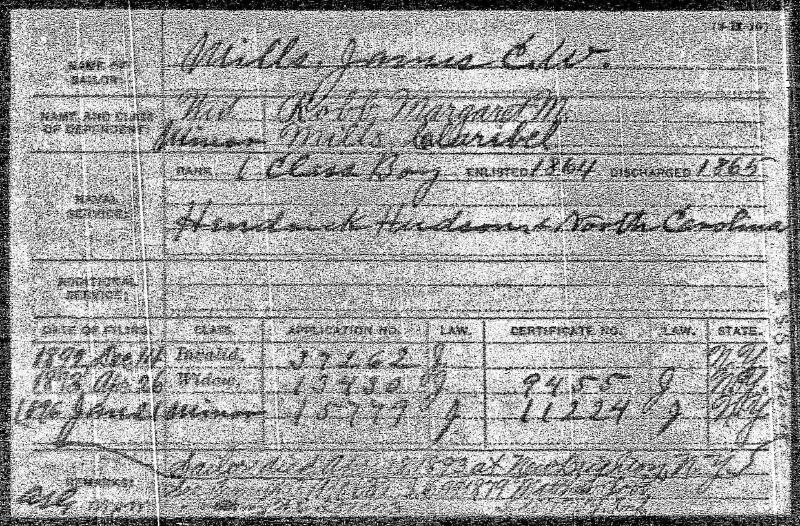
— U.S., Civil War Pension Index: General Index to Pension Files, 1861-1934, ancestry.com. View largest available size.
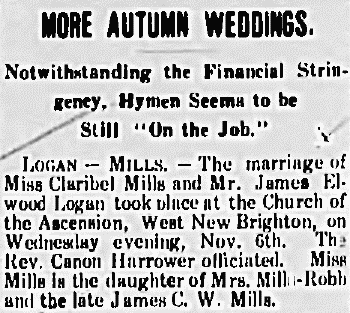
MORE AUTUMN WEDDINGS.
Notwithstanding the Financial Stringency, Hymen Seems to be Still “On the Job.”
Logan—Mills. — The marriage of Miss Claribel Mills and Mr. James Elwood Logan took place at the Church of the Ascension, West New Brighton, on Wednesday evening, Nov. 6th. The Rev. Canon Harrower officiated. Miss Mills is the daughter of Mrs. Mills-Robb and the late James C. W. Mills.
— 09 Nov 1907, Richmond County Advance, West New Brighton NY, p1, nyshistoricnewspapers.org. View largest available size.
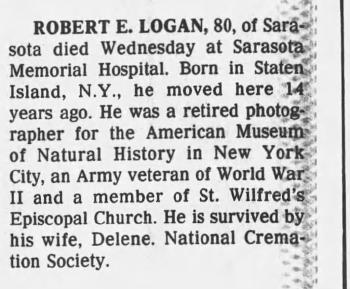
ROBERT E. LOGAN, 80, of Sarasota died Wednesday at Sarasota Memorial Hospital. Born in Staten Island, N.Y., he moved here 14 years ago. He was a retired photographer for the American Museum of Natural History in New York City, an Army veteran of World War II and a member of St. Wilfred’s Episcopal Church. He is survived by his wife, Delene. National Cremation Society.
— 23 Mar 1991, The Tampa Tribune, Tampa FL, p12, newspapers.com. View largest available size.
And for the sake of completeness, I will add these final Wheelocks. I briefly explored the family of Charles Wheelock (1787 in Wexford Ireland to 12 Oct 1868) who married Lydia Alice (Brown) Wheelock (1798 in Brooklyn NY to 06 Feb 1872, Ithaca NY) on 08 Jun 1824 in Brooklyn NY before later moving to the Trumansburg NY area. He was a tallow chandler (candle maker) and a farmer. I found no evidence connecting them to the Mills. The second Pastor of the Congregational Church of Mott’s Corners, from 1868 to 1870, was Reverend Rufus A. Wheelock (03 Mar 1815 to 01 Dec 1891), although after a brief exploration of his life and service to a number of congregations, I cannot find any evidence connecting him to the Mills at any time or place.
“Chief Wheelock” Historical Marker, left
This area was the camping ground of Chief Wheelock, an Oneida Indian, who was killed in action in the War of 1812. After that, the indians no longer camped here.
— A Drive-by Tour of the Town of Caroline sponsored by the Town of Caroline Bicentennial Committee 1994-1995, Tour 1 - P2.
Wheelock is overwhelmingly used as a surname, but I have found rare instances of it being used as a first name. Like the Mills and Seaman names, Wheelock has English origins.